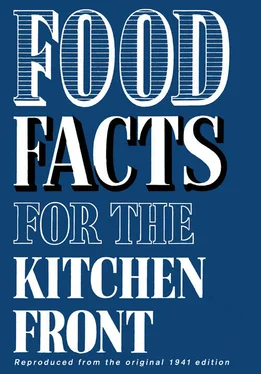For whole mushrooms, the simplest ways of cooking are best. Grill them if you can. Wash them first, then peel the caps, cut off the stalks (which go into hotpot stew, or, chopped fine, into soups or sauces) and dry lightly.
Brush the caps and underside with melted margarine or oil, sprinkle with salt, and lay on the grid. Turn with a couple of spoons or tongs during cooking, but be careful not to leave them too long under the strong heat. Serve on squares of toast as a savoury snack or supper serving.
Mushrooms are also good fried in a very little fat, or stewed gently with a little stock or milk and water. Remember to season them well, and thicken the stock with a little blended flour just before serving.
Used instead of spinach, nettles are excellent food. Rich in the two vitamins A and C, the young leaves are especially good. They should be gathered early in spring.
Wash them well, and allow a good panful, as you would for spinach. Cook in their own juices, with a very little water.
When young and tender, they will take about ten minutes, after which they can be drained, the water put aside for soup, and the vegetable chopped finely and reheated in a little fat if you can spare it. Margarine is best for flavour, when butter cannot be spared. Add seasoning, a grate of nutmeg, heat through, and serve.
Nettles are an excellent ingredient for the Irish recipe with potatoes. See page 53, POTATOES, for the foundation method.
The Irish way of eating “champ” is for each person to make a hole in the centre of his helping in which a pat of margarine is gradually melted by the heat of the potato. As he eats from the outer rim of the helping, he dips each spoonful into the melted fat.
When onions are plentiful, remember that they are delicious parboiled and stuffed or made into an ovenbake.
4–6 onions.
1 oz. dripping.
Seasoning.
Prepare the onions, peeling them and splitting into halves or quarters. Melt the dripping in a fireproof dish, by placing it in the oven, then arrange the onions in it, seasoning well.
Pour in about a teacupful of water. Simmer the onions, basting every few minutes, until they have become a good colour, then allow to simmer for a further half-hour to forty minutes, according to the size and type of onion.
4 large sized onions.
Salt and pepper.
For the Filling—
4 oz. browned breadcrumbs.
2 oz. minced meat.
Salt and pepper.
Peel the onions and simmer in a little salted water until tender. Drain (saving the water) and scoop out the centres. Chop the centres and mix with the stuffing ingredients, moistening with a little onion water if necessary. Fill the onions with the mixture and bake them on a lightly greased baking tin until brown on top. A few browned breadcrumbs sprinkled over the top helps to crisp them.
If you have a cottage kitchener, try baking onions in their skins. They take rather a long time, about 2 hours in a moderate oven, but they have a splendid flavour and are particularly comforting in cold weather.
To bake onions more quickly, first steam for about ten minutes then place in the oven for 1 hour.
Dry all the outside onion skins in a moderate oven until crisp enough to crumble. Store in an airtight tin and use for flavouring soups and stews.
Like carrot, parsnip is a root with good sugar content. For this reason it is delicious when cooked in a very little fat—either baked beneath the meat or fried.
A good way to cook parsnips is to boil them whole (30 to 40 minutes), after careful washing, keeping on the skins. These can then be rubbed off quite easily when the vegetable is tender.
A little finely shredded raw parsnip adds a new and delicious flavour to a mixed vegetable salad. Cooked parsnip, cut into neat dice, can also be used in salads.
Parboil or steam the parsnips, divide into two lengthwise and remove the centre cores. Fill with forcemeat made of breadcrumbs seasoned with mixed herbs, salt and pepper, and bound with a little milk. Put the halves together again and secure with string. Dot with dripping and bake in a moderate oven until golden brown, basting frequently.
1 lb. (cold) cooked parsnips.
1 gill vegetable stock or milk.
1 oz. flour.
1 heaped teaspoon vegetable extract.
1 oz. dripping or cooking fat.
Salt, pepper.
Sieve, or mash the parsnips with a fork, till creamy. Then make a thick sauce with the fat, flour, and stock (in which the vegetable extract has been dissolved, see p. 115). When cooked and thick, work in a few breadcrumbs if liked.
Add the parsnips, and season to taste. Then set aside to firm on a plate. Divide into 10–12 pieces, and form into croquettes.
Roll in browned breadcrumbs, or dip in a flour and water batter (mixed very thinly) and coat in crumbs, patting them on well. Fry in a hot fat till golden brown on both sides. Alternatively—the cakes could be baked.
Конец ознакомительного фрагмента.
Текст предоставлен ООО «ЛитРес».
Прочитайте эту книгу целиком, купив полную легальную версию на ЛитРес.
Безопасно оплатить книгу можно банковской картой Visa, MasterCard, Maestro, со счета мобильного телефона, с платежного терминала, в салоне МТС или Связной, через PayPal, WebMoney, Яндекс.Деньги, QIWI Кошелек, бонусными картами или другим удобным Вам способом.












